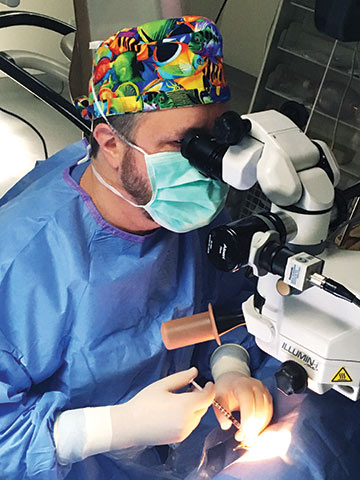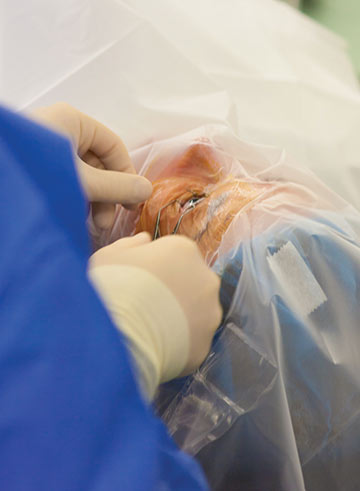Six Surface Disinfection Concepts
The puzzle of superior surface disinfection is never solved....
This website uses cookies. to enhance your browsing experience, serve personalized ads or content, and analyze our traffic. By clicking “Accept & Close”, you consent to our use of cookies. Read our Privacy Policy to learn more.
By: Daniel Cook
Published: 1/15/2019

OPENING UP Most surgeons routinely use a topical or intracameral medication to keep pupils dilated throughout surgery. | Jeffrey Whitman, MD
Small pupils are a sizable concern for your cataract surgeons. They increase the risk of serious complications, including damage to the iris, capsular tears, vitreous loss, and retained lens fragments and cortical material. It’s estimated that about 10% of cataract patients are at risk of intraoperative miosis, so chances are your surgeons will have to deal with the issue at least once during a busy day of surgery. Thankfully, there are several drugs and devices that will dilate pupils wide enough to give physicians the views they need to perform safe and effective surgery. Here’s a rundown.
Pharmaceutical options for maintaining pupil dilation do not involve the mechanical manipulation of the iris, so there’s less risk of cystoid macular edema developing after surgery, says Rex Hamilton, MD, MS, FACS, a cataract and refractive surgeon at Santa Monica (Calif.) Eye Medical Group. Dr. Hamilton says most surgeons routinely use topical or intracameral agents to create intraoperative mydriasis, but differ in their drugs of choice. He typically injects Shugarcaine (a lidocaine-epinephrine compound) to keep pupils dilated.
Lidocaine provides anesthetic comfort and also paralyzes the pupil’s sphincter muscle, causing the pupil to open wide, says Kevin Miller, MD, chief of the cataract and refractive surgery division at the David Geffen School of Medicine at UCLA. Shugarcaine stimulates the pupil’s dilator muscle, which also helps to maintain pupil dilation, he adds.
Surgeons also commonly opt for tropicamide and phenylephrine or a longer-lasting agent such as cyclopentolate, says Dr. Miller, adding that NSAIDs are an underappreciated option for helping to maintain pupil dilation.
“That’s where Omidria comes into play,” he says.
Omidria, the intraocular irrigating solution that’s administered through balanced saline solution during surgery, contains the NSAID ketorolac and the dilating agent phenylephrine. It’s indicated and FDA-approved to maintain pupil dilation and improve post-op healing, but it’s also an expensive drug (about $465 per 4-ml vial) in a specialty with razor-thin margins. However, the cost concern was mitigated when CMS decided last October to reinstate Omidria’s pass-through status until Oct. 1, 2020. That means you can bill CMS separately for about $500 (Omidria’s sales price plus 6%).
Omidria’s FDA approval ensures it’s safe for use in patients, which isn’t always the case with compounded mydriatics, says Dr. Hamilton, who calls Omidria an “excellent option” for maintaining intraoperative miosis, and says the CMS carve out should make the drug available for more widespread use.

Are devices that stretch the iris and expand the pupil more reliable than mydriatic agents? Dr. Hamilton thinks so. “There’s no question that they will provide dilation,” he says. “That’s not always true with pharmaceutical agents. Injecting Shugarcaine in patients with risk factors for small pupils might not have much impact on maintaining mydriasis.”
Surgeons look for several features when assessing the functionality of pupil expansion devices, says Dr. Miller, including being packaged in injectors that make it easy to place them in the eye, engage the pupil without a lot of manipulation, maintain the pupil’s sphincter muscle and distribute force symmetrically around the pupil. Several options check most of those boxes:
Dr. Hamilton says the Malyugin ring is an “elegant device” that comes with an injector system for easy placement and removal through a 1.8mm-incision. He also points out that its 8 points of fixation create an octagon-shaped opening with an even stretching of the pupil. Rounded, blunt eyelets make inadvertent capsule tears less likely during placement. Additionally, research headed by renowned cataract surgeon David Chang, MD, showed the ring safely and reliably maintains pupil diameter with minimal iris trauma in patients with intraoperative floppy iris syndrome.
“It demands a sequential approach to circumferentially engage the iris, and that makes it a bit more challenging,” he says. “It’s also a bit bulkier, and the extra mass demands extra caution to prevent it from coming in contact with the cornea.”
Both the XpandNT and the Iris Expander provide the largest pupillary aperture, says Steven Silverstein, MD, FASC, an ophthalmic surgeon in Kansas City, Mo. He adds that the XpandNT allows for ideal centration, particularly in eccentric, or otherwise distorted pupils, especially those with traumatic sphincter rupture.
Dr. Miller says pupil rings are typically safer to use than iris hooks, with which surgeons have a tendency to overstretch the iris. Still, he says, the devices aren’t without inherent risk.
Warns Dr. Silverstein, “Surgeons must be careful when inserting and removing any mechanical device in order to avoid causing iatrogenic iris trauma or permanent iris cosmetic distortion.”
Dr. Hamilton echoes that word of caution. “These are incredible devices that work exceptionally well, but they’re not without issue,” he says. “Iris manipulation releases proinflammatory mediators, which increase the risk of cystoid macular edema. It’s not something we do without seriously considering the consequences.”
Pseudoexfoliation syndrome, uveitis, diabetes, eye trauma and advanced age continue to be common risk factors for poor pupil dilation. And the number of cataract patients who show up for surgery with small pupils is only expected to increase, especially as more older men suffering from prostate enlargement are prescribed Flomax, an alpha blocker that has been shown to constrict the iris sphincter muscle.
But your surgeons have plenty to address and manage pupil dilation problems. “The essential point,” says Dr. Hamilton, “is that we now have devices and pharmaceuticals that are quite useful in avoiding many of the complications associated with small pupils during cataract surgery.” OSM
The puzzle of superior surface disinfection is never solved....
Boston Children’s Hospital is renowned for its exemplary care on many fronts, including surgery....
Manual cleaning done properly is effective for eradicating microorganisms....